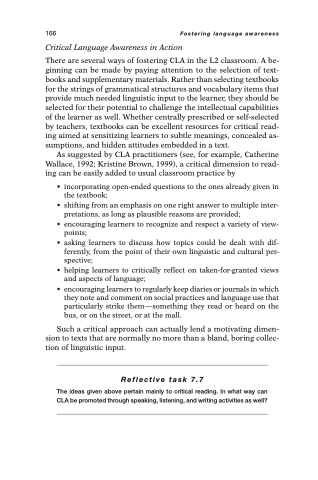Page 178 - Beyond Methods
P. 178
166 Fostering language awareness Critical Language Awareness in Action
There are several ways of fostering CLA in the L2 classroom. A be- ginning can be made by paying attention to the selection of text- books and supplementary materials. Rather than selecting textbooks for the strings of grammatical structures and vocabulary items that provide much needed linguistic input to the learner, they should be selected for their potential to challenge the intellectual capabilities of the learner as well. Whether centrally prescribed or self-selected by teachers, textbooks can be excellent resources for critical read- ing aimed at sensitizing learners to subtle meanings, concealed as- sumptions, and hidden attitudes embedded in a text.
As suggested by CLA practitioners (see, for example, Catherine Wallace, 1992; Kristine Brown, 1999), a critical dimension to read- ing can be easily added to usual classroom practice by
• incorporating open-ended questions to the ones already given in the textbook;
• shifting from an emphasis on one right answer to multiple inter- pretations, as long as plausible reasons are provided;
• encouraging learners to recognize and respect a variety of view- points;
• asking learners to discuss how topics could be dealt with dif- ferently, from the point of their own linguistic and cultural per- spective;
• helping learners to critically reflect on taken-for-granted views and aspects of language;
• encouraginglearnerstoregularlykeepdiariesorjournalsinwhich they note and comment on social practices and language use that particularly strike them—something they read or heard on the bus, or on the street, or at the mall.
Such a critical approach can actually lend a motivating dimen- sion to texts that are normally no more than a bland, boring collec- tion of linguistic input.
Reflective task 7.7
The ideas given above pertain mainly to critical reading. In what way can CLA be promoted through speaking, listening, and writing activities as well?


